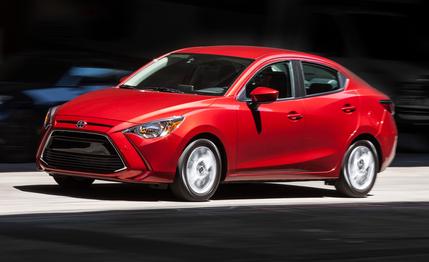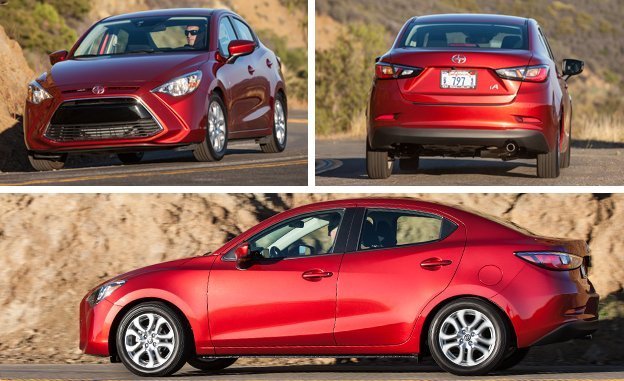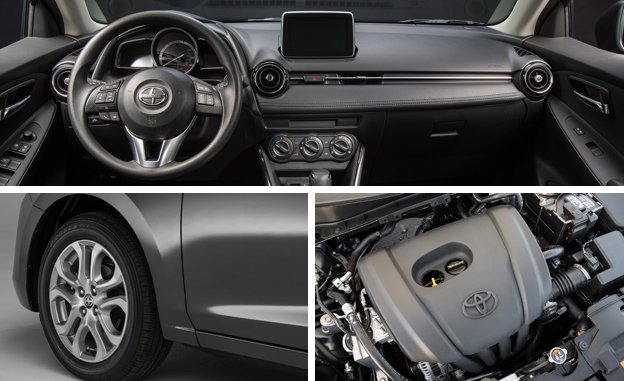 First Drive Review
First Drive Review
The 2016 Scion iA is a great little car, but there are two things we’re all going to have to get over in regard to the new subcompact. First, Scion rebadged a Mazda 2 to bring the iA to life. And second: its awkward nose.
Those may or may not be insurmountable hurdles, depending on your aesthetic sensibilities and/or your loyalty to the scrappy zoom-zoom brand from Hiroshima. The iA is, after all, merely the sedan version of the sassy Mazda 2, which until just last month was expected to arrive in U.S. Mazda dealerships by the beginning of 2016 in handsome hatchback form. But Mazda has decided to pull the plug on the 2 for the U.S. and Canadian markets at least in the near term—the car had already received EPA fuel-economy estimates and everything—ostensibly to focus on its more profitable models. So the Scion iA is our only access to the new Mazda 2 in any form. And it’s a car that, as it turns out, is every bit as sweet to drive as we could have hoped.

As for the Scion’s schnoz, we’re told it was designed by Toyota stylists in Japan for this car, which will be sold not just as the Scion iA in the United States but also as the Toyota Yaris sedan in Mexico and Canada. (Incidentally, Toyota will continue selling us the French-built Yaris for now in hatchback form only, although the next-gen model eventually moves to the Mazda 2 platform, as well.) The headlamps and hood are Mazda pieces, as is everything aft of them; only the “soft parts” (bumper, grille, etc.) of the front end are unique to the iA. This means that from pretty much every angle, it looks like a shrunken Mazda 3, not a Toyota/Scion anything, and it felt rather unnatural to force ourselves to see the car as a Scion when we encountered the little sedans coming and going during the press drive in Malibu, California. Then again, we’re car people; few folks shopping in this segment are likely to notice and even fewer will care.
What they will (and should) care about is the car’s compelling packaging, high level of equipment, and outstanding dynamics. The interior is essentially unchanged from the Mazda 2, which squeezes most of the Mazda 3’s style and technology into subcompact dimensions. While it looks and feels utterly incongruous to all other Scions, including the new iM hatchback (which also arrives in dealerships in September), that doesn’t take away from the cabin’s overall excellence. We like its motorcycle-inspired gauge cluster, seven-inch stand-up infotainment screen, iDrive-type control dial in the center console, and the sweet, three-spoke Mazda steering wheel. Essentially, Scion merely selected the upholstery colors (black with blue accents) and equipment—much of which probably would have been optional on the Mazda 2, by the way—that will come standard in its “mono spec” model.
For a more complete list of those items, check out our coverage of the iA reveal, but the high points include cruise control, air conditioning, push-button ignition, a rear camera, 16-inch alloys, two years of free maintenance, and even a low-speed collision-mitigation system. That’s quite a lot of goodies for $16,495 with a manual or $17,595 with an automatic. Any add-ons are considered accessories, including navigation, which is expected to cost about $400. Sadly, nowhere on the accessories list is the Mazda 2 nose, although it would probably be an easy-ish swap for someone so inclined.

The best news by far is how well the iA drives thanks to the Mazda 2 mechanicals. Those include its 106-hp 1.5-liter Skyactiv four-cylinder, which we wouldn’t consider muscular, yet it makes easy work of scooting the roughly 2400-pound iA through traffic. The engine feels sinewy and smooth, making revving to the 6000-rpm horsepower peak a real joy. Full torque, all 103 lb-ft of it, is available at 4000 rpm. Unsurprisingly, we prefer the six-speed manual on account of its short throws, precise gates, and light clutch. But we can’t fault those who choose the excellent six-speed automatic, which allows the torque converter to do its thing at launch to smooth takeoff before locking it for crisp, direct shifts. There’s also a Sport shift mode, activated via a toggle switch at the base of the shifter.
The meandering ribbons of pavement that connect Malibu to the San Fernando Valley gave us ample opportunities to savor the sublime handling and the suspension’s ability to manage body motions. Feedback pours through the iA’s small-diameter steering wheel, and turn-in is crisp but never darty. The brakes, too, bite with supreme confidence. We noticed none of the noise or harshness that can sometimes accompany twist-beam rear axles like the one in this Scion. And speaking of noise, the iA’s interior counts as practically monastic in a class where raucous is the norm.
It’s a bit sad that Mazda declined to offer a car this good to us under its own banner. But we should be grateful it’s available here at all, even if it means you have to go to the Scion store to find it.